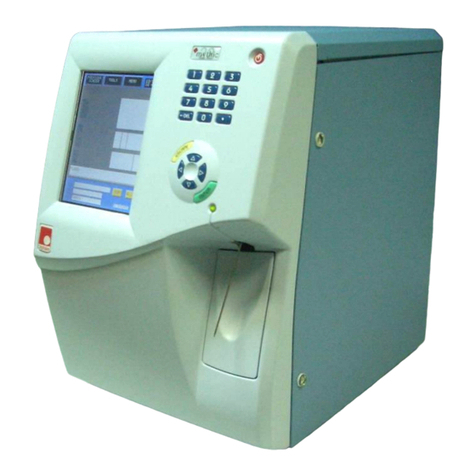
Copyright© Orphée SA. All Rights Reserved.
4.4.1 Recommendations............................................................................................................................................................................. 44
4.4.2 Interferences.................................................................................................................................................................................. 44
5. SAMPLE ANALYSIS .................................................................................................... 49
5.1 VERIFICATIONS BEFORE STARTING.................................................................................................................................................... 49
5.2 START UP.............................................................................................................................................................................................. 49
5.3 REAGENT REPLACEMENT ...................................................................................................................................................................... 50
5.4 START UP...............................................................................................................................................................................................51
5.5 PREPARATIONS BEFORE ANALYSIS ......................................................................................................................................................51
5.6 ANALYSIS............................................................................................................................................................................................. 52
5.6.1 Introduction ..................................................................................................................................................................................... 52
5.6.2 Sample Identification..................................................................................................................................................................... 52
5.6.3 Sample run........................................................................................................................................................................................ 54
5.7 RESULTS ............................................................................................................................................................................................... 55
5.8 PRINTING ............................................................................................................................................................................................. 57
5.8.1 Model report (A4) – external printer........................................................................................................................................... 57
5.8.2 Model report – Thermal printer.................................................................................................................................................... 58
5.9 LOGS ..................................................................................................................................................................................................... 59
5.10 ARCHIVE ............................................................................................................................................................................................. 59
5.10.1 Results ............................................................................................................................................................................................. 60
5.10.2 View...................................................................................................................................................................................................61
5.11 STAND BY AND SHUT DOWN.............................................................................................................................................................. 62
6. QUALITY CONTROL .................................................................................................... 63
6.1 INTRODUCTION.................................................................................................................................................................................... 63
6.2 QC ........................................................................................................................................................................................................ 63
6.2.1 Change................................................................................................................................................................................................ 64
6.2.2 Run control blood............................................................................................................................................................................. 65
6.2.3 Levey-Jennings graph ..................................................................................................................................................................... 66
6.2.4 Restore.............................................................................................................................................................................................. 66
6.3 REPEATABILITY.................................................................................................................................................................................... 66
7. CALIBRATION .......................................................................................................... 68
7.1 RESULTS................................................................................................................................................................................................ 69
7.1.1 Calibration blood analysis ................................................................................................................................................................ 69
7.1.2 Calibration ......................................................................................................................................................................................... 70
7.2 TARGET VALUE MODIFICATIONS......................................................................................................................................................... 70
8. TECHNOLOGY ........................................................................................................... 72
8.1 DETECTION PRINCIPLE ......................................................................................................................................................................... 72
8.1.1 WBC, RBC, PLT Counting.................................................................................................................................................................. 72
8.1.2 Five-part diff measurement........................................................................................................................................................... 73
8.1.3 Hemoglobin measurement ............................................................................................................................................................... 74
8.2 LEUCOCYTE ANALYSIS ......................................................................................................................................................................... 75
8.3 ERYTHROCYTE ANALYSIS .................................................................................................................................................................... 76
8.4 ANALYSIS OF PLATELETS .................................................................................................................................................................... 77
8.5 FLAGS ................................................................................................................................................................................................... 78
8.5.1 General Flags .................................................................................................................................................................................... 78
8.5.2 Instrument Flags............................................................................................................................................................................. 78
8.5.3 Leucocytes Flags ............................................................................................................................................................................. 79
8.5.4 Erythrocyte and HGB Flags........................................................................................................................................................... 80
8.5.5 Platelets Flags.................................................................................................................................................................................. 80
8.5.6 QC Flags............................................................................................................................................................................................ 80
8.5.7 STARTUP Flags ............................................................................................................................................................................... 80
8.6 HYDRAULIC DESCRIPTION ....................................................................................................................................................................81
8.6.1 Sampling module................................................................................................................................................................................81
8.6.2 Counting bath module.......................................................................................................................................................................81
8.6.3 Syringes module................................................................................................................................................................................81
8.6.4 Optical manifold ...............................................................................................................................................................................81
8.6.5 Optical bench................................................................................................................................................................................... 82
8.7 SOFTWARE ........................................................................................................................................................................................... 82
8.7.1 Windows ............................................................................................................................................................................................ 82
8.7.2 Menu tree ......................................................................................................................................................................................... 83
9. SERVICE ................................................................................................................. 84
9.1 MAINTENANCE ..................................................................................................................................................................................... 84
9.1.1 Maintenance table ............................................................................................................................................................................ 84






























